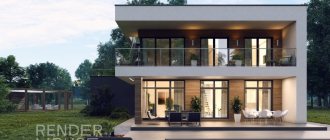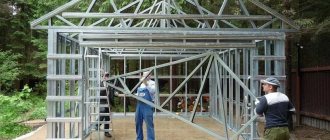When building a permanent garage for your car on an individual housing construction site or in a SNT, many standards must be taken into account. You need to understand at what distance from the fence you can build a garage in order to avoid problems with neighbors. It is necessary to determine in advance the list of permits for the construction of buildings of this type. This will allow you to avoid problems upon completion of the construction of a garage next to the fence due to violation of the distance norm according to SNiP (SP), fire regulations and legal requirements.
In a private house
Rules and regulations
The construction of buildings on the site must be carried out without violating building codes and regulations (SNiP, SP), which determine the technical and legal requirements in terms of architectural surveys and urban planning.
In the cottage
To be able to register a new building as a real estate property, you need to obtain the appropriate permission.
The exception is the following circumstances:
- The idea of building a garage is not connected with the desire to make a profit from renting it out, repairing vehicles, and so on.
- They are also going to install a car box on land owned by the owner, designated for housing construction or non-profit gardening activities (SNT or dacha cooperative).
- The car box does not have a foundation, for example, a metal one. Therefore, it does not apply to capital construction projects.
Construction in the Moscow region in rural areas.
In all other cases, the owner of the site is obliged to contact the architectural department of local authorities, providing the following documents:
- a written statement with mandatory information (from whom, to whom, circumstances and essence of the request);
- certificate or document confirming ownership of land;
- a copy of the identity document of the owner of the land plot;
- basic topographic reference to the area;
- technical documentation with BTI assessment information;
- main cadastral plan for housing construction and surrounding areas;
- scheme for entering communications into the housing construction area;
- project.
Having accepted the application, the official is obliged to issue a receipt to the applicant stating that the documents have been accepted for consideration. The decision on whether it is possible to build a garage in the declared location is made within ten working days. In practice, this procedure takes longer.
If a negative decision is received, then the documents must be returned according to the list. The applicant has the right to re-submit a petition to the same body after changing the construction plan or may appeal to the courts to appeal an administrative, in the opinion of the applicant, unlawful refusal.
Compliance with safety regulations
The first regulatory document that you need to pay attention to is the law of the Russian Federation dated December 30. 2009 No. 384-FZ “Technical Regulations on the Safety of Buildings and Structures” (hereinafter referred to as Law No. 384-FZ). Basic safety principles relevant to low-rise and homestead construction. Such objects include a garage.
Principle 1. Buildings and structures should not pose a threat of mechanical damage. Buildings and structures should not threaten people with mechanical destruction and injury as a result of these destructions. There should be no threat of mechanical damage to other buildings and engineering structures. As an example, we can consider a situation where a neighbor installs his garage in such a way that the garage door, when opened, destroys the fence of your property. The situation, at a minimum, leads to a scandal between neighbors, and at maximum to a trial.
Principle 2.
During operation and during the construction of houses and premises for economic or technical purposes, fire safety rules must be taken into account. Today, the regulatory approach to low-rise civil construction has been weakened. The fire danger of an object (if it is used for business) in the private household is determined by the owner himself. It is necessary to take into account the rules (SP 42.13330.2011, SNiPs: 2.07.01-89, 02.31.2001, 02.30.97, 2.01.02-85) and fire safety rules established by technical regulations (law dated 07.22.2008 No. 123-FZ, hereinafter referred to as Regulation No. 123-FZ).
Principle 3.
During the construction and operation of buildings, outbuildings (including garages) and engineering support structures, it is necessary to comply with sanitary safety standards and not use materials or technologies that pose a threat to human health.
Principle 4.
Environmental consequences must be taken into account. It is prohibited to harm nature.
Principle 5.
The designs of buildings and structures must be designed for possible natural disasters characteristic of the area where construction is taking place.
Principle 6.
Houses, garages, outbuildings, and structures supporting them should not cause situations leading to injury to people. Houses and outbuildings on the site must be located in such a way as to exclude the possibility of injury to a person.
Principle 7.
Buildings and structures today must be energy efficient. Compliance with this principle (use of modern energy saving technologies) allows the owner to save on operating costs. The owner saves his money and saves natural resources and energy on a national scale.
Today there are no special requirements for buildings such as a garage for one or two cars on the territory of a private household. Compliance with these principles makes it possible to arrange all outbuildings on the site as conveniently as possible, to provide for possible emergency and non-standard situations as much as possible, and to maintain good neighborly relations.
Standards for distance from buildings and boundaries of neighboring plots
Obtaining a building permit largely depends on compliance with the requirements of SNiP (SP) in the construction project, in particular, whether the minimum permitted distances to courtyard buildings, neighboring houses and infrastructure facilities are observed during the construction of a garage.
Location of buildings on the individual housing construction site according to SNiP and SanPiN
SNiP norms for 1997, as well as SP 53.13330.2019, prescribe the following for outbuildings, which include a car room:
- distance from residential buildings, if the garage is attached - 3 meters;
- distance to other outbuildings (barn, separate attic, etc.) from 1 m;
- the distance from the fence to the garage is from 1 meter;
- at least 1 m to the bush;
- distance from trees of average height from 2 meters;
- the distance between the extension and tall trees is from 4 m;
- the distance to the neighbor’s residential building is at least 6 meters;
- to the “red line” (the border of private households and municipal land) more than 5 m.
Read: A solid fence between neighbors according to the law 2021: a summer cottage in SNT and a private house of individual housing construction in the Russian Federation.
It must be remembered that a garage cannot be built close to the fence, namely:
- You need to make a 1 meter indentation from your neighbors' fence.
- If there is no fence, then you must retreat 1 m from the neighboring border of the property.
Fencing in the private sector
Subtleties
Important restrictions on the placement of the car box and the functioning of its individual structural elements:
- If the garage is attached to the house, then the distance to the nearest building should be at least 3 m.
- When placing the box with the gate facing the street, a distance of 3 meters from the road must be maintained.
- The distance from the garage to the roadway in villages and cities is at least 5 m, while the calculation of the distance is made from the base of the building or roof if its protrusion exceeds 0.5 meters.
- If one of the sides is adjacent not to the neighbor’s fence, but to an alley, then the distance to the road should be less than 3 meters.
- Installation closer than 2 meters to a power line support is not permitted.
Setbacks from the border of a neighbor’s property according to SNiP and SanPiN standards.
Violation of SNiP regulations, in case of unauthorized construction, is not a basis for initiating administrative or criminal proceedings.
But the initiation of a complaint by a neighbor or an investigation into the consequences of an emergency due to the fault of an attached building will lead to the court making a decision precisely in accordance with SNiP.
Additional Tips
To ensure a truly high-quality entry, it is important to take into account the requirements for each of the components of the solution. Optimal grades of cement - M400 and M500
Its consistency should be dry and free-flowing
The optimal grades of cement are M400 and M500. Its consistency should be dry and free-flowing.
It is best to use river sand with a fraction of 1.5 to 5 millimeters.
It is recommended to use crushed stone or gravel as a filler, the size of which varies from 8 to 35 millimeters. Sea pebbles, due to their polished surface, are not able to provide reliable adhesion to the solution.
When preparing the solution, it is necessary to use clean water, free of acids and alkalis. Therefore, river and lake water are not suitable.
Adding auxiliary components to the solution will help improve the quality and performance properties of a concrete structure. These include:
- Plasticizers for adjusting fluidity and viscosity;
- Slaked lime, which facilitates the installation process;
- Reinforcing agents to increase strength (for example, polyvinyl chloride or polypropylene fiber).
It is best to carry out work on creating a concrete entrance at temperatures from +3 to +25⁰С. If the process occurs in winter, it is necessary to heat the solution, organize uniform heating of the structure, and also use special additives with antifreeze properties.
Share this article with your friends on social media. networks!
Minimum offsets from the red line
The previously mentioned property line designation of land is an important factor in determining the feasibility of construction in the selected location.
As a rule, on state territory near private houses there are lighting poles, information signs, etc.
Main gas supply lines, water supply and drainage communications are hidden underground. They are combined with pedestrian paths, and in many cases, highways and local roads.
How much do you need to retreat during construction?
Construction restrictions make it possible to ensure unhindered 24-hour access to life support lines for the population. The master plan (GPZU) of any settlement contains the exact location of the red lines. If in the documentation submitted for approval the distance from it to the box is less than 5 m, then a negative answer will most likely be received.
There is a high probability that if the construction of a building was carried out without taking into account the distance to the red line, the owner will be forced to demolish it by court decision.
Concrete entrance: step-by-step detailed instructions for pouring
Before pouring concrete into the entrance, let's calculate the size of the garage. To do this, the most convenient and practical way is to draw a scale diagram. It will allow you to calculate the consumption of materials and the timing of the work.
There should be a gap of 2–3 cm between the entrance and the gate so that the gate does not jam due to heaving of the soil.
Required:
- cement M400 30 kg – approximately 3 pcs.,
- sand and gravel (medium or fine fraction),
- lumber (for formwork),
- plasticizer,
- reinforcement 5–9 mm,
- concrete mixer or trough,
- a couple of buckets,
- shovels and bayonet shovels.
| On the site in front of the gate, we remove the soil to a depth of 35–40 cm. The width should exceed the width of the gate, as can be seen in the photo. | |
| Pour sand in a layer of about 7 cm. | |
| Compact with a hand tamper. | |
| Sprinkle with water to thicken. And we make a second similar layer. | |
| Then we fill it with crushed stone/gravel. | |
| We level and tamp. | |
| It was decided to expand the landscaped area in front of the garage using crushed stone. First remove the plant layer and spread geotextiles so that the crushed stone does not mix with the ground over time. | |
| They pour crushed stone. | |
| Formwork is installed on three sides (not on the foundation side). Lay a layer of waterproofing. In this case, linochrome is used. The insulation is extruded polystyrene foam of 5 cm thickness. | |
| The reinforcement frame is tied together. | |
| Now let's prepare a solution to concrete the entrance. The ratio of cement, sand and crushed stone is 1:3:5, respectively. Add a plasticizer (ordinary Fairy can act as it; pour it on the eye; when foam begins to form during mixing, that’s enough). When pouring, use a vibration compactor. | |
| The main layer is filled. Its thickness is approximately 15 cm. | |
| Now lay a 50x50 cm mesh. | |
| Fill in the finishing screed; do not add crushed stone when mixing the mortar. The ratio of cement and sand is 1:4. | |
| Level the screed with a rule or a flat board. | |
| When the screed has settled a little, dry concrete is sprinkled on top. This will increase its waterproofing properties. | |
| Iron tie. | |
| Ready screed. |
Subtleties of construction next to wooden buildings
The proximity to a courtyard where a wooden residential building is built increases the mandatory distance to 15 meters. At the same time, the right to agree with the owner on reducing this distance is retained. The agreement is drawn up in writing and certified by a notary.
The same procedure for neighbors to resolve the issue applies to brick buildings, if it is necessary to build a room for a car at a distance of less than 6 m. A prerequisite for receiving a positive answer from a neighbor is to ensure sufficient fire safety measures.
Norms on the individual housing construction site
To do this you need:
- install an external shield with recommended fire-fighting accessories;
- place a fire extinguisher in the room;
- ensure that the room is not heated;
- place the electrical power supply distribution panel outside the building;
- equip the electrical panel with an automatic load switch;
- trace the wires in a protective metal sleeve;
- equip lighting devices with factory shades.
If the above recommendations are not followed, you may not only lose the opportunity to resolve the issue peacefully, but also aggravate the situation as a whole.
Thus, guided by Article 304 of the Civil Code of the Russian Federation, the owner of a neighboring plot may demand that construction and operation be brought into compliance with fire regulations. Failure to comply with the permitted construction distances is a direct possibility of fire spreading.
Read: Safe distance from a cell tower to a residential building: norms and harm to health, law
In the country
Concrete screed
If the soil of your site is quite calm and not subject to swelling, then a concrete platform for a car in the country may be a good option. This material is quite durable, but the work is performed in the following order:
- Before pouring concrete into the area under the car at the dacha, we make a depression along the entire width of the proposed parking lot. Its size depends on the weight of the car. If your car is small and fairly light, the thickness of the concrete layer can be 10 cm. For a heavy brand, the layer should be no thinner than 15-20 cm.
- Along the entire perimeter of the territory we arrange formwork from boards secured with pegs. Its height should correspond to the thickness of the coating.
- The next step is backfilling and compacting the sand cushion.
- Concrete solution should be poured onto the prepared base to a depth of 5-6 cm. If you plan to use a ready-made mixture, you will have to worry about ordering a special machine. If it is impossible for a large vehicle to drive up to your dacha, you will have to mix the concrete mixture yourself using a concrete mixer.
To obtain the working material, you will have to buy cement, the required amount of sand and a sand-gravel mixture. Using a shovel, the mixed concrete is spread in an even layer on top of the sand cushion.
- Without waiting for setting, reinforcement or reinforcing mesh should be laid on top of the freshly poured concrete.
- A second layer of concrete is poured on top of it.
- Using a trowel, we level the surface. For ease of operation, you will need to set beacons. A slight slope should be provided from the center to the edges to allow water to drain from the parking area.
- After a day, the beacons are removed. The remaining recesses from them are sealed with cement mortar.
- We carry out the final treatment of the surface - using a damp broom we sweep away all the unevenness from the concrete that has not yet hardened, fill it with a thin layer of cement and evenly distribute it with the same broom over the entire surface.
- The formwork can be removed after 3 days.
- Concrete will finally gain its strength after 3 or 4 weeks. Then it will be able to support the weight of the car. It is not advisable to enter the parking lot before the stated time.
Where is the best place to build?
In order to have fewer questions when coordinating documentation with the architects of the local administration, the construction of a capital box should be planned taking into account the following:
- If the building is located inside a courtyard area, then the entry of a car should not be accompanied by additional maneuvers.
- There should be enough space on the inside of the entrance gate to lock the garage door.
- The entrance to the garage, if it is adjacent to the street, must be designed to provide sufficient visibility for the safe maneuver of exiting vehicles.
- Opening the gate should not interfere with the movement of pedestrians and passing cars.
- The building should not block the access of light to the neighbor’s vegetable garden or garden if it contains low-growing varieties of trees.
- Water drainage from the roof must be directed to the territory of its site in the SNT or individual housing construction, both from the roof and along the ground using a ditch.
- Planting your own trees is carried out taking into account the requirements of SNiP (SP).
- If you decide to build a garage adjacent to the house or allocate a basement floor for it, then all fire safety standards must be met. They relate to the equipment of the room with a hood, fire equipment, and a fire alarm.
Norms and rules
If the garage is located in a private house on the ground floor, then fire safety rules allow parking and storing vehicles running on liquid fuel there.
Garage dimensions
When designing, you should calculate the dimensions of the garage to ensure minimal comfortable and safe use. They can be:
- on both sides of the car - 0.75 meters;
- if there are columns - at least 0.5 m;
- from the trunk and hood of the car - at least 0.6 meters;
- with impressive parking dimensions, when parking cars one after another - 0.5 m;
In accordance with SNiP (SP) standards, the ceiling height is taken to be the distance from the surface of the floor covering to the maximum protruding lighting fixture or communication element. The safety gap to the car cannot be less than 0.2 m.
Following the recommendations will not only help you comfortably use the room for its intended purpose, but also in a critical situation.
At the summer cottage
For example, in the event of a fire, this will allow the evacuation of vehicles and stop the spread of fire.
Advantages of concreting
Like all materials, concrete floors have their drawbacks. The main problem is abrasion of the top layer under the mechanical influence of the car’s wheels or the feet of its owner. The result is an unpleasant gray dust that settles well on the surface of the car body, tools and surfaces present in the garage. Concrete tends to absorb various liquids well, and if the composition has an unpleasant odor, this also becomes a problem. And we can also note the labor intensity of the concreting process. But this coating has 3 advantages, because of which concrete will always be the best option for a garage:
- durability,
- strength;
- cheapness.
It is possible to combat the shortcomings of a concrete floor, and there are effective means for this, which will be discussed below.
How much do you need to step back from the fence when building a garage?
In cities and villages, similar situations often arise that have simple solutions, including:
- The owner built a garage close to the fence, but he doesn’t know what to do. The most correct decision is to fulfill all fire safety training requirements and come to an agreement with the neighbor, documenting the absence of objections.
- When a neighbor built a garage next to the fence, without retreating, violating the 1 meter standard, and the side wall is adjacent to the fence, what should you do? If construction took place without approval, then you need to file an application with the court.
- How much should you step back from your neighbor's house if it is wooden and there is no fence around the property? You should focus on the recommended standards - 15 meters. You can install an iron or brick garage after agreement with your neighbor.
- How far should you step back from the fence when building a garage if the red line is 9 meters away? With such a distance from the property line of the land, the minimum distance between the garage and the fence must, by law, be at least 1 meter.
- Settlement in the household after its acquisition occurred later than the time the neighbor built the garage; it turned out that the distances were maintained, and the light did not enter the yard. The courtyard is not a vegetable or garden area. Distances have been maintained, and there is nothing to file claims in court for. In this case, all that remains is to redevelop your site as much as possible.
Read: Distance from the fence to the neighbor’s buildings: new SNiP standards 2020-2021 at the dacha, in a private house
Every year the country's legislation is improved, and SNiP requirements undergo changes. In this regard, to obtain objective information in each specific case, you should seek advice from practicing specialists.
This also applies if difficulties arise when independently preparing a project for a future garage on your individual housing construction site or in SNT.
How many meters to retreat when erecting an individual building on a site is shown in the video below.
What to do if your neighbor's garage has encroached on your property
Many people face the problem when a neighbor's garage is partially located on their land. This happens when buying real estate. If the owner has completed all the documents for the purchased house and plot and is confirmed by an extract from the Unified State Register, he has the right to demand that his neighbor dismantle the garage box on a voluntary basis. If the owner of the neighboring territory does not remove the structure within the specified period after receiving a written notice, they file a claim in court.
In Russia, documents have been adopted regulating the correct development of plots that are privately owned by citizens. If you strictly follow all legal standards when building a garage on a plot of land, you will not have any troubles with the authorities and neighbors due to improper placement of the facility. Building codes and regulations are regularly updated and supplemented with new construction techniques. They need to be studied before carrying out work.
Issue resolution and judicial practice
Clarification of relations between neighbors in the courts is an extreme measure used in cases where it is impossible to find mutual understanding. But if it is not possible to dispose of your land to build a garage due to unfounded claims, then there are no other ways to prove your case.
In the countryside
When considering a case in court, the plaintiff prepares and files a statement of claim, attaching documents of a housing nature that determine the right of ownership. Their list duplicates the necessary papers for approval of the project by the administration architects.
The plaintiff sets out the circumstances and subject of the illegal claims, methods and methods of preventing the exercise of rights on a summer cottage or in a private house. The statement of claim is supplemented with evidence in the case in the form of photographs and video materials.
Before preparing a statement of claim, you should make sure that there are no violations on the part of the plaintiff, and that the norms for distances from residential and auxiliary premises are met.
Otherwise, it will not be possible to count on a positive decision.
Correct location of the boiler room
The boiler room should be located away from the residential building. This is more reliable in terms of fire safety, as well as from the point of view of environmental friendliness, since fuel combustion is accompanied by the release of harmful gases and soot. Also, for safety reasons, all electrical equipment involved in the operation of the boiler room must be installed behind a partition, in a separate room. This is necessary to protect electrical appliances and devices from overheating during operation of the heating boiler.
A garage for a car can be purchased at a garage cooperative or built on a plot of land near the house. The second option involves including a space for building a garage in the site plan. It can act either as a separate building or as an extension to the house if the main building has already been erected. In addition, a garage on the site can be built simultaneously with a residential building, providing an entrance and exit inside the premises, without the need to go outside from the house.
The construction of any facility involves a thorough study of the terrain and soil characteristics.
A flat area without slopes or hills allows you to build a garage on a summer cottage in compliance with standard construction standards. Heaving soils and uneven terrain of the site dictate their own rules for the construction of buildings. Please note that the installation of a garage cannot be carried out in a low-lying area, as this poses a risk of flooding.
In conclusion
When the distance from the garage to the fence or the border of the plot, as well as to other objects on the land plot by the owner of the household, is observed, then the incomprehensible claims of interested parties can be resolved by conducting control measurements.
Car in the country
This data will be sufficient to establish correctness in any authority. There will also be an opportunity to assert your rights in the event of established facts of violations by the owners of neighboring plots in the country or in the private sector in the village.
Basic fire safety requirements for garages
It’s good when the site is large and convenient. Review the projects, choose the one you need and place buildings, gardens, and yard according to your taste. It is more difficult to equip a small and not very convenient area. It does not matter whether a summer house or a house for permanent residence will be built, such buildings as a barn, garage, summer kitchen, gazebo are always desirable and necessary on private property.
This is interesting: The boundaries of the land plot were established more than 15 years ago
Monolithic brick fence combined with a garage
A rational approach to site planning allows you to save space and significantly reduce the cost of landscaping. One of the options for saving space is projects of fences combined with a garage. This method of placing a building has its advantages and disadvantages, its fans and opponents.
The advantages of joint construction include:
To create a single yard style, a garage and a fence with common boundaries must be made of the same material, in a common style.
Projects for the joint construction of a fence and a garage have an option when a common wall with a gate facing directly onto the street becomes common. In this case, the garage door and the gate are made of the same materials, the same color and design.
The second option is a common side wall, and the garage door is located at some distance from the fence gate. In this case, the costs of building two gates are added, but it is possible to park the car in the yard without a garage.
The garage fits best into a fence made of brick or stone; in this case, they create a single picture. Finishing of both the common wall and the rest is carried out with the same materials. A rich look is created by gates with forging elements.
Another excellent material for this type of placement of buildings is corrugated sheeting. Fences made from it have already become firmly established, and garage designs made from corrugated sheets are an innovation, but quickly adopted by car enthusiasts.
This is the simplest material for building both a garage and a fence on your own, and is also affordable.
Smart planning
The garage can be attached or detached.
Both types have structural differences.
Attached
A garage is sometimes combined with a house, a summer kitchen or a bathhouse. It is allowed to add a terrace.
Placed below floor level in the house. It is not necessary to install heating (this is at the discretion of the owners). This garage can additionally be used as a storage room.
Features of an attached garage:
- It has a separate foundation and roof.
- All communications can be carried out in it (electricity, heating, water supply, ventilation).
- Doesn't take up much free space in the yard.
- It is possible to enter the garage directly from the street. It is very convenient when the gate opens automatically.
- Good sound insulation is required.
- It is better not to skimp on roofing materials. It would be optimal to choose the same one as for home.
In two-story houses above the garage, it is not recommended to install bedrooms or living rooms. It is better if it is a library, a billiard room, a greenhouse, that is, a room where a person is only temporarily.
Standing separately
More often the garage is made into a separate building. It can be built from used or budget materials. Soundproofing is not required.
Among the disadvantages of a detached building:
- fA solid foundation needs to be poured.
- To get into the garage, you will have to go outside at any time of year and weather. An alternative is to build a canopy, but this will entail additional costs.
- Additional investments will be required to supply communications to the premises.
In addition, when planning the structure, the following are taken into account:
- How far will the entrance to the yard be? The driveway to the garage should not have any turns.
- Ground water level. This is an important point if the owner wants to arrange a viewing hole or a small cellar inside the room.
- Ground level. For installation, it is worth allocating a part of the yard on a hill so that melt water and precipitation do not flow under the foundation.
- Drainage from the roof of the building. It should be directed only towards its site.
- Side of the world. The northern part of the estate is considered optimal for development. There is always little light in this direction, so growing crops there is not profitable.
When purchasing materials for construction, it is important to look not only at the price, but also to consider the general appearance of the structure. So that the garage looks good with other buildings on the site.
To save space, you should choose roller or sectional garage doors, and to save money, swing doors.
Possible mistakes
What can go wrong:
the size is narrower than the roof overhang - the blind area will not function correctly, you need to initially calculate the width correctly;- there is no storm sewer, no drainage - installation of the drainage system can be done after laying the blind area, the storm sewer can be partially laid on top of the covering, the rest around the perimeter;
- stagnant water appears, which means that the required slope has not been maintained, dismantling and re-installation is necessary, otherwise there is no point in the design;
- the concrete is covered with cracks - this happens if the concrete laying technology is not followed (there were no distribution joints, the layer did not have time to dry, the material was not wetted, etc.), the service life of such a blind area is reduced.
It is necessary to monitor each stage, especially if unskilled builders are involved in creating the blind area. Otherwise, the result will be disastrous, and the foundation will collapse much faster.
The most important and useful information on the construction of blind areas is collected in this section.
When can you shorten the distance without risking breaking the law?
SNiP standards are established taking into account the safety and comfort of living of the owner of the site. But in some cases it is possible to violate these requirements without legal consequences.
Reducing the distance
You can reduce the distance to the fence and other buildings to zero, but only with the consent of the owner of the neighboring territory, certified by a notary. At the same time, it is important to remember about the short duration of such an agreement (3 years) and the risk of a demand for demolition at any time if the land is sold.
Also, with any reduction in distance, increased attention must be paid to compliance with fire safety requirements, since in the event of a fire in a garage located too close to a neighbor’s property, damage to other people’s property is inevitable.
Garage walls instead of a fence
This construction option will significantly save space on the site, but it is also possible only with mutual consent, certified by a notary.
You can build two garages back to back or build two boxes with a common wall that serves as a fence and separates the areas.
In the second case, you can significantly save on materials and reduce the overall construction budget. But at the same time, it is important to remember the risks that come with the expiration of the contract or the sale of one of the plots.











